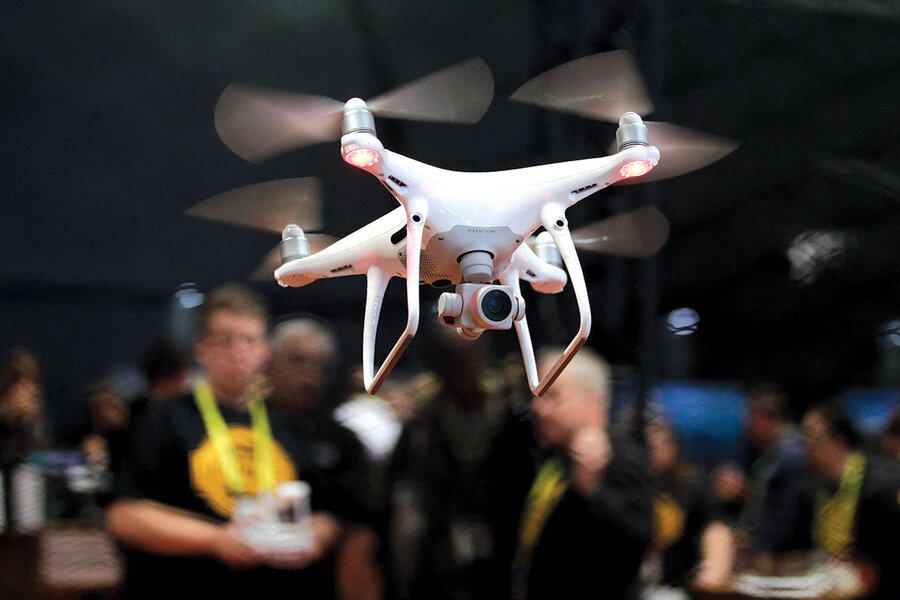Explained: A US pilot program for unmanned aircraft
Loading...
The United States Department of Transportation has picked 10 regional programs to help integrate unmanned aircraft into the airspace. The initiative aims to inform future federal regulations on drones.
Q: What’s happening?
On May 9, Transportation Secretary Elaine Chao announced the selection of 10 state, local, and tribal governing bodies for participation in the Unmanned Aircraft System Integration Pilot Program, a three-year initiative. The program will test a variety of drone programs as part of efforts to safely incorporate unmanned vehicles into US airspace.
Why We Wrote This
Already, the number of registered US drones is more than 1 million. A new pilot program aims to ensure that future federal regulations can keep up with the swelling number of commercial drones.
Under the current rules of the Federal Aviation Administration (FAA), drones cannot fly beyond the sight of their operators, above 400 feet, at night, or above people who are not participating in the operation. These rules, say drone proponents, sharply limit the technology’s potential.
“A lot of the benefits of drones actually come from being able to fly beyond visual line of sight,” says lawyer Lisa Ellman, a partner and the chair of drones practice at the firm Hogan Lovells. “For example, if you’re doing pipeline inspections with a drone, you need to be able to fly [it] farther than your eye can see.”
This program allows the selected governments to partner with drone companies to create regulatory sandboxes – that is, a framework allowing innovators to experiment with their technology, which could be useful when drafting nationwide rules for drones. “We’re at such a critical moment right now for policymaking around the use of drones,” says Ms. Ellman, who is also the co-executive director of the Commercial Drone Alliance and a former Obama White House adviser. “We have to create a regulatory framework that allows them to fly.”
Q: Who was chosen?
Of the 149 applicants, the 10 selectees consist of three state departments of transportation (Kansas, North Carolina, and North Dakota), two cities (Reno, Nev., and San Diego), two county agencies (in Florida and Tennessee), two academic entities (in Alaska and Virginia), and Oklahoma’s Choctaw Nation.
In making the selections, the US Department of Transportation wanted to include a variety of airspaces, geographical features, and climatic conditions.
The technology partners affiliated with the selectees include Google’s parent company, Alphabet, as well as start-ups such as AirMap and Flirtey. Two glaring omissions were Amazon, which has been promising drone delivery for Prime subscribers since 2013, and the Chinese technology company DJI, which controls about 70 percent of the civilian and commercial drone market.
“While it’s unfortunate the applications we were involved with were not selected,” said an Amazon spokesman in a statement, “we support the Administration’s efforts to create a pilot program aimed at keeping America at the forefront of aviation and drone innovation.”
Q: What will the drones be doing?
In Alaska, they’ll monitor permafrost and unstable soils to aid pipeline operators. In Florida, a 1,500-pound drone will help control the mosquito population, while in San Diego, unmanned aircraft will be used for border patrol. And in Reno, drones will deliver defibrillators and other medical equipment.
In fact, five of the 10 selected projects include package delivery, which, aside from a handful of modest trials, has largely been conducted overseas by US businesses.
“The idea here is to have industry partners with the city or state or a tribe working closely with the FAA to push these policy boundaries forward for the good of innovation,” Ellman says.
Q: How many civilian drones are in the US currently?
The FAA began requiring registration for unmanned aircraft in December 2015. By January of this year, the number of registered US drones had topped 1 million. Those who want to use drones for commercial purposes need a special license from the FAA. As of this past September, some 60,000 licenses had been issued.
As the technology gets cheaper and more sophisticated, drone businesses are facing competition from both start-ups and big corporations. One drone photographer told the Spokane, Wash., Spokesman-Review that he used to make $2,000 a day snapping aerial photos of the East Coast. Now, the same work nets him about $175.
Q: What does this mean for ordinary Americans?
Some 70,000 jobs will be created in the three years after drones are integrated into US airspace, generating an economic impact of more than $13.6 billion, projects the Association for Unmanned Vehicle Systems International, a trade group based in Arlington, Va.
Still, nobody can predict how drones will change the way consumers purchase goods and services.
“When the cellphone was first invented, you never envisioned that you were going to do all your banking on your cellphone,” says Ellman. “The limits of this new technology are limited only by our imagination.”








